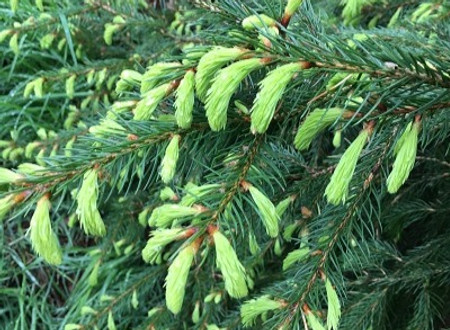
Spruce - Picea spp

Main features
-
Coniferous tree growing between 20 and 90m
-
Often found in plantations and gardens
-
Has leaves/needles attached singularly to the branches/twigs
-
Each leaf/needle has a brown notch (peg) at its base which remains attached when the leaf/needle is removed
-
The leaves/needles are spiky/prickly
-
The cones have some flexibility
Spruce - Picea
Edible tree - novice
Other common names Varies between species but usually suffixed with "Spruce" eg Norway Spruce
Scientific name meaning Picea is derived from Latin and means "Pitch Pine". This is in reference to the fact that Spruce was used to manufacturer pitch prior to petrochemicals
Season All year
Habitat - where will I find it? Often found in plantations, Spruce is grown for its use as a decorative tree for Christmas celebrations and for timber. It is also found in garden planting schemes. It is native to the mountainous areas across Europe, the USA and Canada.
Description - what does it look like? Spruces are coniferous trees growing up to between 20 and 90m.
The leaves/needles of Spruce are spiky/prickly and attached singularly to the tree, and right around the twig/branch. At the base of each leaf/needle is a small brown notch, known as a peg. When the needles are removed, the pegs remain giving a very rough feel to the twigs.
The cones of the Spruce have some flexibility.
Possible lookalikes Other coniferous trees. The ways to separate are spruces singularly attached spiky/prickly leaves/needles, with brown peg at the leaf/needle base.
Yew (Taxus spp) is deadly poisonous, and can be distinguished as its leaves/needles are flat and not spiky/prickly like Spruce's
Use as a food The young tips soft that emerge in springtime can be used raw or cooked. They have a strong citrus-like flavour and are rich in vitamin C. Raw, they can be roughly chopped and sprinkled through salads, used to make pesto, infused into alcohol, or steeped in warm water to make tea. Cooked, they can be used to make syrups, jellies, candies, and jams, or to flavour hot dishes. They work particularly well with Thai cuisine recipes.
The male catkins can be used to as a flavour enhancer, and the centre of the young female cones can be eaten after roasting
Use in herbal medicine Has been used as an antiseptic, expectorant, antibiotic and sedative
If you are suffering from any ailment or need medical advice, please see your General Practitioner
Other uses Used in the production of pitch and turpentine, and as a source of tanning. The oils are used in perfume making and the pulp is important in papermaking
Hazards Make sure only the younger paler tips are used, as older leaves/needles are prickly
Importance to other species Spruce forms a dense canopy so prevents most plants and other trees from growing underneath it.
However, it provides cover for large mammals, nesting sites for birds, and forms mycorrhizal releationships with many species of fungi
Always stay safe when foraging. You need to be 100% sure of your identification, 100% sure that your foraged item is edible, and 100% sure that you are not allergic to it (it is good practice to always try a small amount of any new food you are consuming). If in doubt, leave it out!

